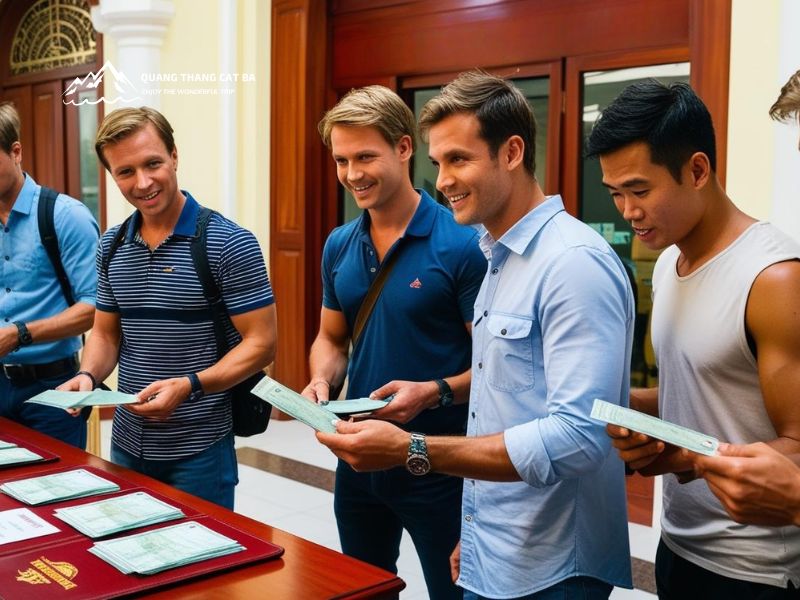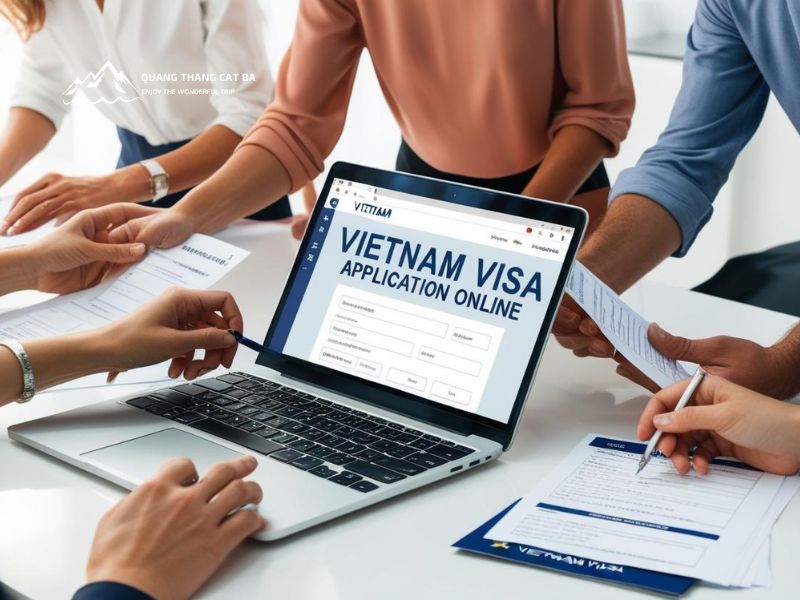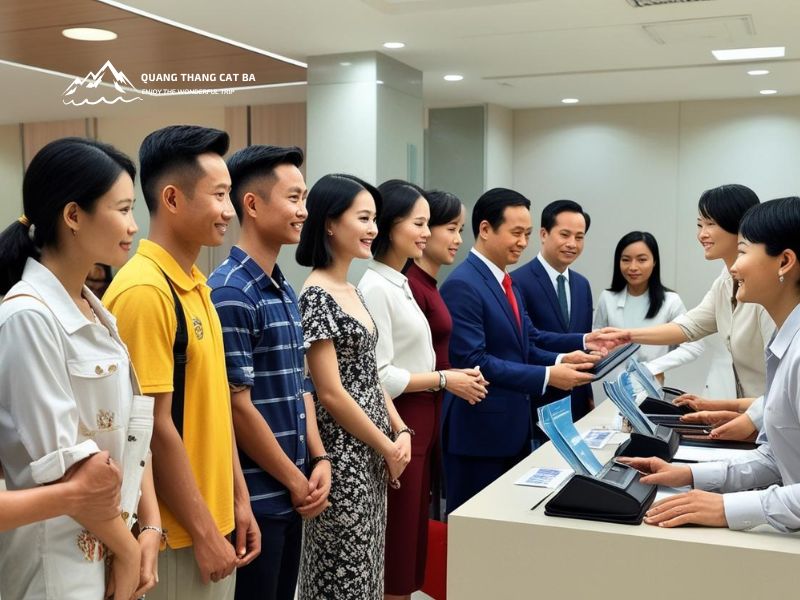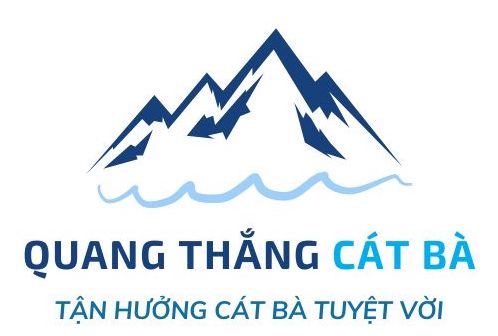Planning a trip to Vietnam? Our complete application guide explains everything you need to know about getting a Vietnam visa. Learn about visa options, required documents, fees, and processing times. Whether you're applying for an e-visa, visa on arrival, or through an embassy, this guide ensures smooth travel planning!
Overview of How to Get a Vietnam Visa
Obtaining a Vietnam visa can be done through various methods such as an e-visa, visa on arrival (VOA), or by visiting a Vietnamese embassy or consulate. Some travellers may be eligible for visa exemptions, depending on their nationality or purpose of visit. Follow these five key steps to ensure a smooth visa application process, based on your travel needs.

Summary of Key Steps
- Step 1: Determine the type of visa you need
Vietnam offers multiple visa types, including the e-visa, visa on arrival, and standard visa. The e-visa is convenient for tourists, allowing a 90-day stay with either single or multiple entries. - Step 2: Prepare necessary documents
Basic requirements include a passport valid for at least six months, passport-sized photos, a completed application form, and proof of payment. For an e-visa, digital uploads of these documents are mandatory. - Step 3: Choose the application method
- E-visa: Apply through Vietnam’s official immigration website.
- Visa on Arrival: Request a pre-approval letter from authorised agents before departure.
- Embassy Application: Submit documents in person or by post at a Vietnamese embassy.
- Step 4: Submit the application and pay the required fee
Ensure all documents are complete before submitting. For e-visas, the processing fee is $25 USD, payable online. Embassy applications may have varying fees based on the visa type and service level. - Step 5: Receive your visa and check entry conditions
Upon approval, print your e-visa or receive your stamped passport. Carefully verify all visa details to prevent entry issues. Contact your nearest embassy for corrections if necessary.
Types of Vietnam Visas Available
Vietnam provides a variety of visas depending on the traveller's purpose, ranging from short-term tourist visas to long-term work or family visas. Each visa type has unique conditions, including validity, entry options, and documentation requirements. Knowing which visa you need helps streamline the application process, ensuring you meet both your travel and legal needs effectively.

Tourist Visa
Tourist visas are designed for leisure travellers visiting Vietnam for up to 90 days.
- Duration and entry options:
Available as 30-day or 90-day visas, with single or multiple entry options, depending on your travel plans. - Application requirements:
Applicants must provide a valid passport, passport-sized photos, a visa application form, and proof of payment for fees.
Business Visa
Business visas cater to individuals attending meetings, signing contracts, or conducting business activities.
- Eligibility and required documents:
Applicants need an invitation letter or sponsorship from a registered business in Vietnam. Other documents include a passport and completed application form. - Multiple-entry vs single-entry options:
Business travellers can choose between single or multiple entry visas, offering flexibility for repeat visits within the validity period.
Other Types of Visas (Work, Family, etc.)
- Work Visa:
Issued to those working in Vietnam, typically requiring a work permit, proof of qualifications, and health clearance. - Family Visa:
Dependents of foreign residents or Vietnamese citizens can obtain a 12-month visa, subject to providing proof of relationship. - Other Visa Types:
- Student Visa (DH) for education or internships.
- Investor Visa (DT) for business investors.
- Diplomatic Visa (NG) for government representatives.
- Conference Visa (HN) valid for up to 90 days.
Choosing the correct visa ensures compliance with Vietnamese regulations and smooth travel planning.
Vietnam Visa Exemption Policies
Vietnam has established visa exemption agreements with various countries, allowing visa-free entry for specified durations. This policy simplifies travel for tourists, particularly those with short-term visits. Understanding the eligible countries, length of stay, and specific exemptions ensures travellers can fully benefit from the exemption without any visa-related delays or issues.
List of Countries Eligible for Visa Exemption
As of 2023, citizens of 26 countries can enter Vietnam without a visa. Countries include:
- 90 days: Chile, Panama
- 45 days: Belarus, Denmark, Finland, France, Germany, Italy, Japan, Russia, South Korea, Spain, United Kingdom, others
- 30 days: Cambodia, Indonesia, Singapore, Malaysia, Thailand
- 21 days: Philippines
- 14 days: Brunei, Myanmar
Duration of Visa-Free Stay and Conditions
The allowed visa-free stay varies based on nationality, typically ranging from 14 to 90 days. Some countries also have additional regulations, such as limits on continuous stays over 180 days for visa-exempt entries.
Information on Specific Exemptions
- Phu Quoc Island Exemption: Visitors can stay visa-free for up to 30 days on Phu Quoc Island, even when transiting through other Vietnamese airports.
- APEC Business Travel Card Holders: Exempt from visas for stays of up to 60 days.
- Special Tourism Programs: New exemptions include 45 days for travellers from Switzerland, Poland, and the Czech Republic under organised tour programs.
These policies enhance accessibility and convenience for international travellers visiting Vietnam.
How to Apply for a Vietnam Visa
Applying for a Vietnam visa can be done through three main methods: e-visa, visa on arrival (VOA), or via a Vietnamese embassy. Each method has specific requirements, processing times, and fees. Choosing the right application process based on your travel needs can ensure a smooth and hassle-free experience.
Applying for an E-Visa
The e-visa is a convenient, fully online option for eligible travellers.
- Accessing the official e-visa portal: Apply at the official Immigration Department website (evisa.xuatnhapcanh.gov.vn).
- Filling out the application form: Provide personal and trip details, upload a passport photo and passport data page.
- Payment and document upload process: Pay the $25 fee online and receive your visa after 3-5 working days.
Applying for a Visa on Arrival
Visa on arrival is ideal for those entering through major airports.
- How to get a pre-approval letter: Apply online through an authorised agency to receive an approval letter before departure.
- What to bring to the airport for VOA processing: Bring your passport, approval letter, photos, and cash for the fee.
- Stamping fee and procedure at the airport: Pay the fee ($25 single entry, $50 multiple entry) at the VOA counter to get your visa.
Applying at a Vietnamese Embassy or Consulate
Embassy applications are recommended for those requiring longer stays or multiple visits.
- Appointment and document submission process: Submit your application in person or by mail, along with the passport, photos, and other required documents.
- Additional requirements based on the country of application: Processing time is typically five working days, but embassies may request further documents or interviews based on local regulations.
Vietnam Visa Requirements
To successfully apply for a Vietnam visa, travellers must meet specific document requirements. These typically include a valid passport, passport-sized photos, and a completed application form. Depending on the visa type, additional documentation such as an invitation letter or sponsorship approval may be needed to support your application.
Overview of General Requirements
- Passport: Valid for at least six months beyond your stay with two blank pages for visa stamps.
- Photos: Recent, passport-sized photos (4 cm x 6 cm) with a white background.
- Application Form: A completed Vietnam Visa Application Form.
- Proof of Payment: Evidence of fee payment.
Additional Documents Needed for Specific Purposes
- Letter of Invitation: May be required for tourism, business, or long-term stays.
- Business Visa: Needs an approval letter from a sponsor or employer in Vietnam.
- E-Visa Application: Requires a scan of the passport bio page, photo, and address in Vietnam.
- Visa on Arrival: Pre-obtained Letter of Approval and travel details.

By preparing these documents, you can ensure a smoother visa application process without unnecessary delays.
Vietnam Visa Costs and Processing Times
Understanding the costs and processing times for various types of Vietnam visas is essential for effective trip planning. Different methods such as e-visa, visa on arrival, and embassy applications come with varying fees depending on entry type and service level. The following sections provide detailed information on each option.
E-Visa Fees and Processing Time
The e-visa is a fast, fully online solution with fixed government fees.
- Standard processing time and expedited options: Processing usually takes 3-5 working days, though expedited services can reduce this to 2-3 working days.
- Breakdown of fees: The government fee is $25 USD for a single-entry visa and $50 USD for multiple entries. Additional service fees may apply when using agencies.
Visa on Arrival Fees
Visa on arrival (VOA) is ideal for those entering through major international airports in Vietnam.
- Cost of the approval letter and airport stamping fee: Travellers must pay for a pre-approval letter from an authorised agency and a stamping fee upon arrival. The stamping fee is $25 USD for a single entry and $50 USD for multiple entries.
- Differences between tourist and business visa fees: Business visas typically have higher pre-approval fees due to the additional documentation required.
Embassy Visa Application Costs
Embassy applications are often required for long-term or complex travel purposes.
- Processing times at embassies and consulates: Processing generally takes 5-7 working days, though expedited services may be offered for a fee.
- Variation in fees: Visa fees can vary based on the country of application. Check with your local Vietnamese embassy for up-to-date rates.
Table of Visa Costs and Processing Times
|
Type of Visa |
Processing Time |
1-2 Pax Fee |
3-4 Pax Fee |
5+ Pax Fee |
|
30 days single entry |
5-7 working days |
$58 |
$57 |
$56 |
|
30 days single entry |
4 working days |
$71 |
$70 |
$68 |
|
30 days single entry |
3 working days |
$74 |
$73 |
$72 |
|
30 days single entry |
2 working days |
$79 |
$78 |
$77 |
|
30 days multiple entry |
5-7 working days |
$83 |
$82 |
$81 |
|
30 days multiple entry |
4 working days |
$96 |
$95 |
$93 |
|
30 days multiple entry |
3 working days |
$99 |
$98 |
$97 |
|
30 days multiple entry |
2 working days |
$105 |
$104 |
$103 |
|
90 days single entry |
5-7 working days |
$60 |
$59 |
$58 |
|
90 days single entry |
4 working days |
$71 |
$70 |
$68 |
|
90 days single entry |
3 working days |
$74 |
$73 |
$72 |
|
90 days single entry |
2 working days |
$79 |
$78 |
$77 |
|
90 days multiple entry |
5-7 working days |
$88 |
$87 |
$86 |
|
90 days multiple entry |
4 working days |
$101 |
$100 |
$98 |
|
90 days multiple entry |
3 working days |
$102 |
$101 |
$100 |
|
90 days multiple entry |
2 working days |
$105 |
$104 |
$103 |
This table highlights the full charges (including government fees) based on the type of visa, group size, and processing time.
Common Issues and Solutions
Applying for a Vietnam visa can sometimes lead to issues like application rejections, processing delays, or errors in visa information. Identifying potential problems and understanding how to address them can help avoid travel disruptions and ensure a smooth visa application process.

Visa Application Rejections
Application rejection is one of the most common issues applicants face.
- Reasons for rejection and how to avoid them:
- Invalid documents: Ensure your passport has at least six months validity and two blank pages.
- Incorrect details: Double-check that application information matches your passport exactly.
- Incomplete documents: Submit all required forms, photos, and proof of payment.
Providing accurate and complete information is crucial to prevent rejection.
Delayed Visa Processing
Visa processing delays can disrupt travel plans, especially for urgent trips.
- Factors causing delays and how to follow up with authorities:
- Application errors: Mistakes in personal details or missing documents can cause delays.
- Processing time: Apply at least one month before your travel date to allow for standard processing.
- Follow-up: Contact the embassy or immigration office if your visa status remains unresolved beyond the expected timeline.
Errors in Visa Information
Mistakes in visa details can result in entry denial or other issues at border control.
- Steps to correct mistakes in visa details:
- Review your e-visa: Check for errors in personal information or visa validity upon receipt.
- Immediate correction: Contact the issuing authority (embassy or immigration department) to amend any inaccuracies before traveling.
Addressing errors promptly ensures a hassle-free entry to Vietnam.
FAQs About Getting a Vietnam Visa
Below are answers to common questions about obtaining a Vietnam visa, covering application methods, documentation, fees, reliability, and visa extensions. Understanding these frequently asked questions can help you plan your trip smoothly and avoid complications.
How can I apply for a Vietnam visa?
- Overview of available methods: You can apply through an embassy or consulate, either in person or by mail. Alternatively, apply for an e-visa online via the official Immigration Department website or get a Visa on Arrival (VOA) by securing a pre-approval letter.
What documents do I need for a Vietnam visa application?
- General and specific requirements for various visa types:
- Basic documents: Valid passport (at least six months remaining), passport-sized photos, and a completed application form.
- Additional requirements: For business, study, or conference visas, you may need a Letter of Approval from relevant Vietnamese authorities.
How much does a Vietnam visa cost?
- Explanation of fees and potential additional costs:
- E-visa: $25 USD for single entry and $50 USD for multiple entries.
- Visa on Arrival: You must pay both a service fee for the approval letter and a stamping fee ($25 USD single entry, $50 USD multiple entry) at the airport.
Is the visa on arrival process reliable?
- Benefits and drawbacks of using the VOA option:
- Benefits: Convenient for those arriving through major airports.
- Drawbacks: Requires a pre-approval letter, which may involve service fees and potential delays. After arrival, you need to queue at the VOA counter to pay the stamping fee.
Can I extend my Vietnam visa?
- Conditions and procedures for visa extensions:
- Submit an application form for visa extension (form NA5), along with supporting documents such as proof of stay, financial ability, and a valid passport. Extensions are subject to approval by the Immigration Department or local authorities.
Useful Links and Contact Information
For a smooth visa application process, it’s crucial to have access to reliable information sources. Below are key links and contact points that can guide you in applying for a Vietnam visa, checking entry regulations, and accessing other essential travel resources.
- Official Vietnamese Immigration Portal:
Access the Vietnam Electronic Visa Portal at thithucdientu.gov.vn or evisa.gov.vn. These are official sites for e-visa applications and immigration updates.
- Contact Details for Vietnamese Embassies and Consulates:
Locate the nearest Vietnamese embassy or consulate by searching online for your country's Vietnamese diplomatic mission. Embassy websites typically provide visa requirements, application forms, and contact details.
- Additional Travel Resources (Immunisation, Entry Regulations):
- Visit the Vietnam Immigration Portal to check entry pre-clearance procedures and electronic approval for foreign travellers (Immigration Portal).
- For immunisation advice, consult your healthcare provider or national health travel advisory services to ensure you meet health entry requirements.
These resources help ensure you're well-prepared for your trip to Vietnam, reducing the risk of delays or complications at entry points.
Securing a Vietnam visa doesn’t have to be complicated. By understanding the available options, requirements, and fees, you can easily plan your trip without unnecessary delays. Whether you’re applying for an e-visa, visa on arrival, or through an embassy, preparation is key. Visit Quang Thắng Cát Bà for more travel insights and support for your Vietnam adventure!

